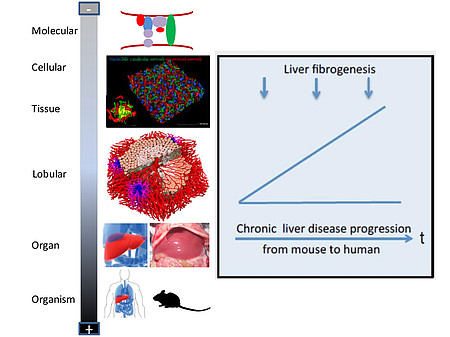Sie befinden sich hier
Inhalt
Liver Systems Medicine to understand disease progression and resolution
Chronic liver diseases (CLD) frequently develop by continuous injury through different insults, e.g. high caloric diet, drug abuse, viral infections and alcohol consumption. This tissue damage triggers chronic inflammation, which induces a fibrogenic response involving parenchymal and non-parenchymal liver cells. CLD progression leads to cirrhosis and ultimately cancer, organ failure and death.
The only current treatment option is liver transplantation, whereby availability is strongly limited and thus, more than 170,000 people die of liver diseases annually in Europe. Because of the complexity of CLD, a holistic systems medicine approach is advised to integrate available and newly generated data into mathematical models for improved interpretation. The overall goal is to define key molecular mechanisms and structural changes in tissue architecture during CLD by visualizing and quantifying at cellular, tissue and organ scale, to propose and validate biomarkers for early recognition and to develop strategies for liver repair that are ultimately applied in the clinic.
To achieve these ambitious goals, we integrate data from animal models and especially validate findings in human patient specimens. Together with modelling experts, we will develop models that recapitulate processes on different scales during liver disease, such as intracellular processes, cell-cell communication, and body homeostasis. Subsequently, these models are also used to predict function of molecules and suggest new treatment strategies in animal models, and later in human patients.
Kontextspalte

PhD- und Masterthesis
If you are interested in performing your Master or PhD in this field of research please contact Dr. Seddik Hammad (Seddik.hammad@medma.uni-heidelberg.de).
Core Facility
Grants
- BMBF – Liver Systems Medicine (LiSyM)
Publications
Collaboration Partners
- Prof. Dr. Christian Trautwein (Clinic for Gastroenterology – Aachen)
- Prof. Dr. Dirk Drasdo (INRIA - Paris)
- Prof. Dr. Jan Hengstler (IfADo – Dortmund)
- Prof. Dr. Ursula Klingmüller (DKFZ - Heidelberg)

